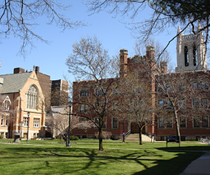Discover
Bridging the Nerve Gap
By restoring bladder function in animal models, spinal cord researchers take a step toward ultimately helping people with permanent paralysis

Jerry Silver, PhD, professor of neurosciences at Case Western Reserve’s School of Medicine, has devoted his professional life to spinal cord research in hopes of finding answers for patients suffering permanent paralysis.
In one experiment, Silver’s lab restored breathing in paralyzed rats. In another, they regained foreleg function.
Now, Silver and Yu-Shang Lee, PhD, assistant staff scientist in the Lerner Research Institute of Cleveland Clinic, have regenerated nerves to return significant bladder function in rats with severed spinal cords—another step toward ultimately restoring bodily functions for paralyzed people. About 273,000 people in the
United States live with permanent spinal cord injuries, according to the National Spinal Cord Injury Statistical Center.
“It just shows clearly that certain nerve fibers that are cut can regenerate really long distances, which is especially exciting,” says Silver, who developed an interest in glial cell biology as a Case Western Reserve medical student. (Glial cells support and protect neurons in the central nervous system.) Their discovery recently appeared in the Journal of Neuroscience.
Specifically, Silver and Lee bridged the gap between severed ends of the spinal cord. They combined a nerve graft with a scar- tissue-dissolving enzyme and treatments to grow nerve cells from the upper back to the lower spine.
As a next step, they hope to test the technique in larger animal models. Silver says those discussions could begin later this fall.
“I’d like to see a robust replication of this,” he says.
They’re also considering testing the bridge technique on chronic, or older, spinal cord injuries in rats. They want to explore this area because most patients live with chronic injuries. That would require, in essence, awaking dead nerves to stimulate growth. So far, they’ve worked only with acute, or fresh, injuries in which nerves are still “alive” and more apt to grow.
